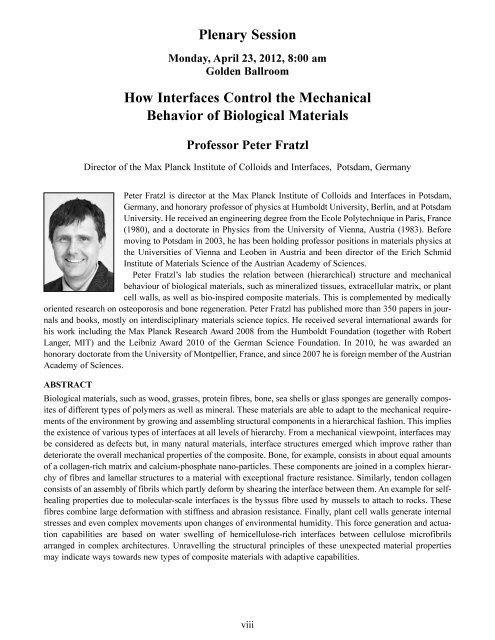ICMCTF 2012! - CD-Lab Application Oriented Coating Development
ICMCTF 2012! - CD-Lab Application Oriented Coating Development
ICMCTF 2012! - CD-Lab Application Oriented Coating Development
You also want an ePaper? Increase the reach of your titles
YUMPU automatically turns print PDFs into web optimized ePapers that Google loves.
Plenary Session<br />
Monday, April 23, <strong>2012</strong>, 8:00 am<br />
Golden Ballroom<br />
How Interfaces Control the Mechanical<br />
Behavior of Biological Materials<br />
Professor Peter Fratzl<br />
Director of the Max Planck Institute of Colloids and Interfaces, Potsdam, Germany<br />
Peter Fratzl is director at the Max Planck Institute of Colloids and Interfaces in Potsdam,<br />
Germany, and honorary professor of physics at Humboldt University, Berlin, and at Potsdam<br />
University. He received an engineering degree from the Ecole Polytechnique in Paris, France<br />
(1980), and a doctorate in Physics from the University of Vienna, Austria (1983). Before<br />
moving to Potsdam in 2003, he has been holding professor positions in materials physics at<br />
the Universities of Vienna and Leoben in Austria and been director of the Erich Schmid<br />
Institute of Materials Science of the Austrian Academy of Sciences.<br />
Peter Fratzl’s lab studies the relation between (hierarchical) structure and mechanical<br />
behaviour of biological materials, such as mineralized tissues, extracellular matrix, or plant<br />
cell walls, as well as bio-inspired composite materials. This is complemented by medically<br />
oriented research on osteoporosis and bone regeneration. Peter Fratzl has published more than 350 papers in journals<br />
and books, mostly on interdisciplinary materials science topics. He received several international awards for<br />
his work including the Max Planck Research Award 2008 from the Humboldt Foundation (together with Robert<br />
Langer, MIT) and the Leibniz Award 2010 of the German Science Foundation. In 2010, he was awarded an<br />
honorary doctorate from the University of Montpellier, France, and since 2007 he is foreign member of the Austrian<br />
Academy of Sciences.<br />
ABSTRACT<br />
Biological materials, such as wood, grasses, protein fibres, bone, sea shells or glass sponges are generally composites<br />
of different types of polymers as well as mineral. These materials are able to adapt to the mechanical requirements<br />
of the environment by growing and assembling structural components in a hierarchical fashion. This implies<br />
the existence of various types of interfaces at all levels of hierarchy. From a mechanical viewpoint, interfaces may<br />
be considered as defects but, in many natural materials, interface structures emerged which improve rather than<br />
deteriorate the overall mechanical properties of the composite. Bone, for example, consists in about equal amounts<br />
of a collagen-rich matrix and calcium-phosphate nano-particles. These components are joined in a complex hierarchy<br />
of fibres and lamellar structures to a material with exceptional fracture resistance. Similarly, tendon collagen<br />
consists of an assembly of fibrils which partly deform by shearing the interface between them. An example for selfhealing<br />
properties due to molecular-scale interfaces is the byssus fibre used by mussels to attach to rocks. These<br />
fibres combine large deformation with stiffness and abrasion resistance. Finally, plant cell walls generate internal<br />
stresses and even complex movements upon changes of environmental humidity. This force generation and actuation<br />
capabilities are based on water swelling of hemicellulose-rich interfaces between cellulose microfibrils<br />
arranged in complex architectures. Unravelling the structural principles of these unexpected material properties<br />
may indicate ways towards new types of composite materials with adaptive capabilities.<br />
viii




